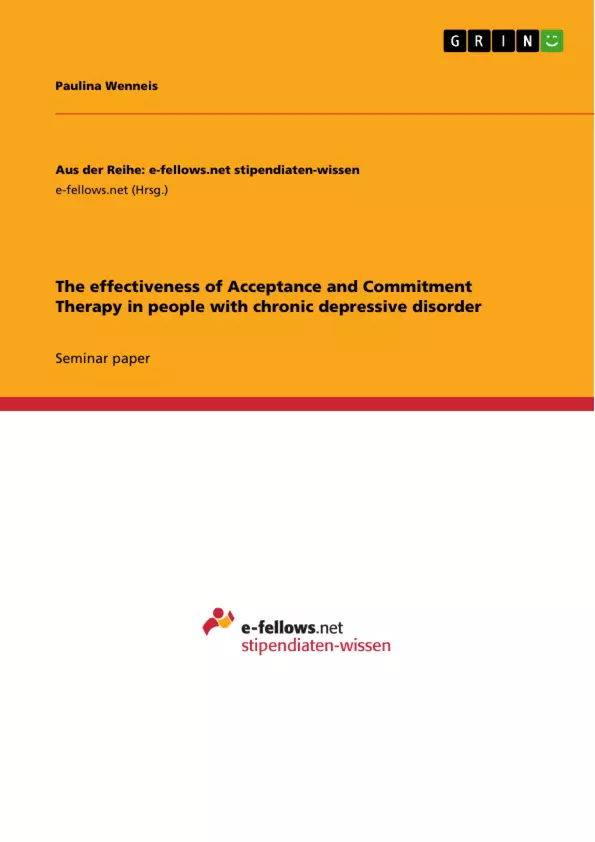In the following assignment I will take a closer look at the usage of the Acceptance and Commitment Therapy (ACT) as a possible treatment for chronically depressed patients.
Affected people showed to be often treatment-resistant to established psychotherapeutic approaches for depression like Cognitive Therapy or Cognitive Behaviour Therapy. The same is equally observable for antidepressant medication, resulting in long and painful ordeals, often accompanying the patients their entire life. That is why a new approach is urgently needed.
As ACT is a relatively recent therapeutic approach with some gaps in empirical data, I will also highlight possible treatment alternatives in psychotherapy and medicine.
Table of Contents
- Theory
- Acceptance and Commitment Therapy
- Basic Model
- Applied Model
- Depressive Disorder
- General overview
- Major Depressive Disorder
- Chronic Depressive Disorder
- Discussion
- How can ACT help people in general?
- ACT for people with Chronic Depressive Disorder
- How does ACT perceive depression?
- Empirical Support / Research
- Are there other approaches which are more effective?
- MBCT and CBASP
- Ultrasound therapy and magnetic stimulation
- Conclusion and personal statement
Objectives and Key Themes
This term paper aims to critically analyze the effectiveness of Acceptance and Commitment Therapy (ACT) for chronically depressed patients. It will examine the theoretical underpinnings of ACT and evaluate the existing empirical evidence supporting its use in this context. The paper will also explore alternative treatment options. * The effectiveness of ACT in treating chronic depression. * A comparison of ACT with other therapeutic approaches. * The theoretical framework of ACT and its core components. * The nature and characteristics of chronic depressive disorder. * The exploration of alternative treatment modalities for depression.Chapter Summaries
Theory: Acceptance and Commitment Therapy: This chapter introduces Acceptance and Commitment Therapy (ACT), situating it within the third wave of behavioral therapies. It details the basic model of ACT, highlighting its emphasis on accepting painful thoughts and feelings rather than attempting to change them directly. The chapter also introduces the applied model, the Hexaflex Model of Psychological Flexibility, which outlines six core processes: acceptance, cognitive defusion, self as context, contact with the present moment, values, and committed action. These processes are explained in detail, demonstrating how they contribute to psychological flexibility and overall well-being. The differences between ACT and other acceptance-based treatments are also discussed, emphasizing ACT's transdiagnostic approach and focus on underlying mechanisms rather than symptom reduction. Depressive Disorder: This section provides an overview of depressive disorders, focusing specifically on the characteristics and challenges of chronic depressive disorder (CDD). It highlights the prevalence of depression and the significant impact it has on individuals' quality of life, physical well-being, and economic stability. The chapter differentiates between depressive symptoms and clinically diagnosed depression, emphasizing the importance of duration and persistence in determining a clinical diagnosis. It sets the stage for exploring the applicability of ACT as a treatment for CDD by detailing the significant unmet need for effective interventions in this population.Keywords
Acceptance and Commitment Therapy (ACT), Chronic Depressive Disorder (CDD), Psychological Flexibility, Mindfulness, Cognitive Defusion, Values, Committed Action, Treatment-resistant Depression, Alternative Therapies, Empirical Evidence, Transdiagnostic Approach.
Frequently asked questions
What is the main topic of this language preview?
This language preview focuses on analyzing the effectiveness of Acceptance and Commitment Therapy (ACT) for patients with chronic depression.
What are the key themes explored in this preview?
The key themes include: the effectiveness of ACT in treating chronic depression; a comparison of ACT with other therapeutic approaches; the theoretical framework of ACT and its core components; the nature and characteristics of chronic depressive disorder; and the exploration of alternative treatment modalities for depression.
What is Acceptance and Commitment Therapy (ACT)?
Acceptance and Commitment Therapy (ACT) is a third-wave behavioral therapy that emphasizes accepting painful thoughts and feelings rather than trying to change them directly. It aims to increase psychological flexibility.
What is the Hexaflex Model of Psychological Flexibility?
The Hexaflex Model is the applied model of ACT. It consists of six core processes: acceptance, cognitive defusion, self as context, contact with the present moment, values, and committed action. These processes aim to improve psychological flexibility.
What is Chronic Depressive Disorder (CDD)?
Chronic Depressive Disorder (CDD) is a persistent form of depression with significant impact on individuals' quality of life, physical well-being, and economic stability. The language preview differentiates between depressive symptoms and clinically diagnosed depression, emphasizing the importance of duration and persistence for clinical diagnosis.
What alternative treatment options are mentioned in the preview?
The preview mentions MBCT (Mindfulness-Based Cognitive Therapy), CBASP (Cognitive Behavioral Analysis System of Psychotherapy), ultrasound therapy, and magnetic stimulation as alternative treatment options for depression.
What are the key words associated with this topic?
The key words include: Acceptance and Commitment Therapy (ACT), Chronic Depressive Disorder (CDD), Psychological Flexibility, Mindfulness, Cognitive Defusion, Values, Committed Action, Treatment-resistant Depression, Alternative Therapies, Empirical Evidence, and Transdiagnostic Approach.
What does the "Theory: Acceptance and Commitment Therapy" chapter cover?
This chapter introduces ACT within the context of behavioral therapies and provides details on both the basic and applied (Hexaflex) models. It highlights ACT's transdiagnostic approach.
What does the "Depressive Disorder" section cover?
This section provides an overview of depressive disorders, with a specific focus on the characteristics and challenges associated with Chronic Depressive Disorder (CDD). It also emphasizes the unmet need for effective interventions for CDD.
- Quote paper
- Paulina Wenneis (Author), 2025, The effectiveness of Acceptance and Commitment Therapy in people with chronic depressive disorder, Munich, GRIN Verlag, https://www.hausarbeiten.de/document/1597592


